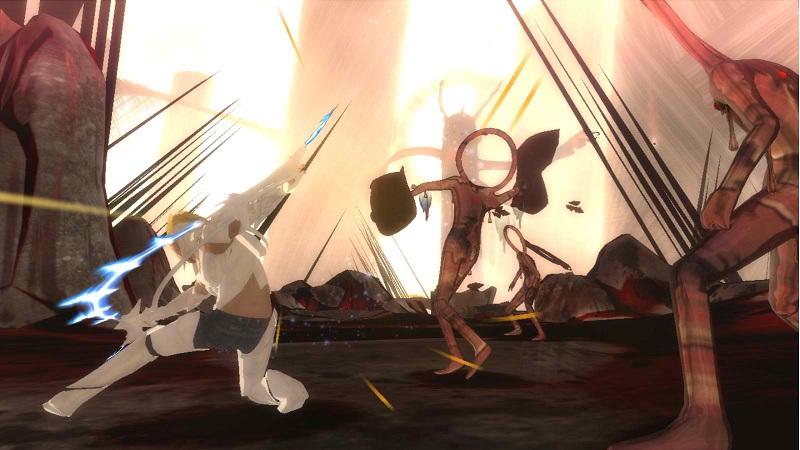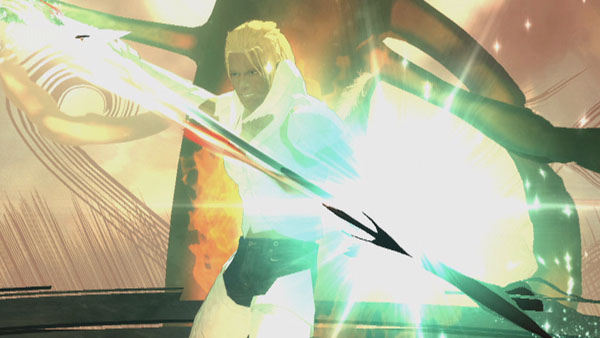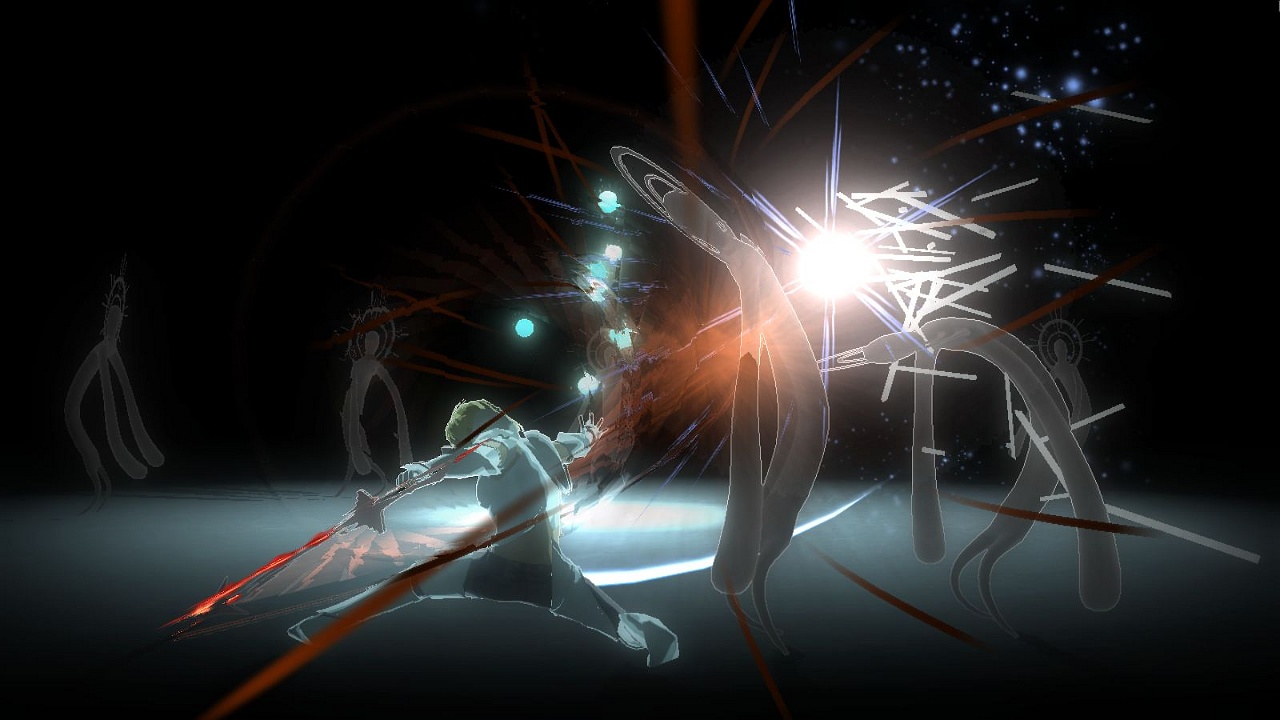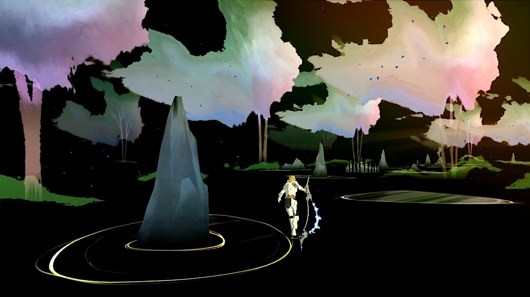Search
[{{{type}}}] {{{reason}}}
{{/data.error.root_cause}}{{{_source.title}}} {{#_source.showPrice}} {{{_source.displayPrice}}} {{/_source.showPrice}}
{{#_source.showLink}} {{/_source.showLink}} {{#_source.showDate}}{{{_source.displayDate}}}
{{/_source.showDate}}{{{_source.description}}}
{{#_source.additionalInfo}}{{#_source.additionalFields}} {{#title}} {{{label}}}: {{{title}}} {{/title}} {{/_source.additionalFields}}
{{/_source.additionalInfo}}- Details
- Category: PlayStation 3
- By scion238
- Hits: 9749
El Shaddai: Ascension of the Metatron (PS3)

El Shaddai
Developer: Ignition Tokyo
Publisher: UTV Ignition Games
Released: 28 Apr 2011 (JP), 16 Aug 2011 (NA), 9 Sep 2011 (EU)
Available On: Playstation 3, Xbox 360
Genre: 3D Action Platformer
ESRB Rating: T
Number of Players: 1
Price: $19.99 (new), $9.99 (used)
(Amazon affiliate link)
El Shaddai: Ascension of the Metatron is the freshman directorial effort from the character designer from Devil May Cry and Okami, Takeyasu Sawaki. Drawing inspiration from the pseudepigraphal Book of Enoch, Sawaki presents players with a tight 3D action/adventure platformer that owes much to both of his previous efforts in both its visual style and mechanics.
In El Shaddai, players assume the role of Enoch, an obscure Old Testament patriarch best-known for his manner of death in Genesis 5:24: “Enoch walked with God, and was not, for God took him.” Over the centuries, many theologians have speculated just what this verse meant, and the basic thrust of the story from 1 Enoch is intact, involving things like cross-breeding between fallen angels and humans, immortal super-powered humans who guard humanity, and fantastic weapons derived from Heavenly technology; but it’s certain nobody, not even William Blake, ever had anything like Sawaki’s vision in mind.
As with his previous effort, Okami, Sawaki retells a mythical tale through the artistic lens of its culture of origin. While in Okami this led to a unified experience, here the results are somewhat schizophrenic. Okami took a Shinto legend and told it through the lens of ukio-e and woodcut; El Shaddai takes a Biblical legend and filters it through the whole of Western art, ranging from painting styles, cinematography, stage production, and well-known video game tropes. Each level receives a different artistic treatment and style, and there is little visual continuity from one stage to another.
The tendency towards psychedelia would be more irritating than amusing, especially in one of the later levels which plays like Salvador Dali's fever dreams, were it not for the fact that El Shaddai is endearing on its own terms. It is gorgeous, hilarious, and outright bizarre in a uniquely Japanese way that I find compelling. On top of that, the game mechanics are as rock solid as they come and you literally have no idea what visual curveballs the designers will throw your way next.

Strong Points: Brilliant art direction, strong mechanics, excellent voice acting, hilariously bizarre humor
Weak Points: Portentious, pointless philosophizing that has no bearing on the gameplay
Moral Warnings: Frequent references to non-canon extra-Biblical books from the ancient Near East.
Before I start talking about that, though, I'd like to take some time to praise what is inarguably the best aspect of 2 Genesis: Cho Aniki Edition El Shaddai, and that is... the gameplay.
El Shaddai’s controls are fluid and one hundred percent reliable. Standard platforming controls are the name of the game, here. Move with the left analog stick. One button jumps and double-jumps. Another attacks. A third attacks slightly stronger. One of the right shoulder buttons blocks. Another purifies your weapon. That's pretty much... hey, wait a minute. Purification? What's that about?
As Enoch, you’re a holy warrior attacking Evil Demonic Scum. When you kill them, they get their evil demonic scum on your weapon, making it less effective. So you have to "purify" the weapon to make it dish out maximum damage again. The purification process is somewhat less than instantaneous, and apparently is accomplished simply by passing one's hand over the weapon. You are completely vulnerable for the duration of the process, though, so you need to give yourself some room.
Attacking is based entirely around two buttons. You can button-mash your way through this game and do okay. However, if you vary the rhythm of your button mashing, you use different attack styles. You may suddenly unleash a launcher that allows you to juggle your enemies Devil May Cry-style. You may find that your weapon transforms into some kind of energy lash, when you were unaware that it could even do that. Finally, you can retaliate with a guard break move by holding down your primary attack button and charging your currently equipped weapon.

Higher is better
(10/10 is perfect)
Game Score - 92%
Gameplay - 18/20
Graphics - 9/10
Sound - 9/10
Stability - 5/5
Controls - 5/5
Morality Score - 69%
Violence - 5/10
Language - 10/10
Sexual Content - 5.5/10
Occult/Supernatural - 5.5/10
Cultural/Moral/Ethical - 8.5/10
You can also steal weapons. Stealing a weapon purifies it in the process, so it's actually more effective to steal one when you're surrounded than it is to try to step back and purify one you already have.
Enoch’s enemies carry one of three types of weapons:
The Arch: Remember those odd-looking two-handed Klingon swords from Star Trek: The Next Generation? They were called bat’leths. The Arch is like a cross between a bat’leth and a lightsaber, which is something I’m surprised no one’s thought of before. It functions primarily as a sword, but its secondary effect is that it lets you drift slowly back to the ground by holding down the jump button while still in midair. Its charge-up move is a short dash forward and two powerful overhead swipes.
The Gale: This is the game's ranged weapon. You obtain it by stealing this… ring-thing from a floating court jester and then six small white floating acorns follow you around. Pushing the attack button snaps Enoch into henshin sentai poses and the little acorns shoot off at nearby enemies and objects. Enoch purifies them by spinning the little ring between his hands. It is frustrating to use at times because its targeting is not well-programmed and you have zero control over your projectiles after you fire them. Secondary effect is a speed dash elsewhere in your immediate area. Charge-up move is the aforementioned energy lash.
The Veil: With a name like that, you'd expect some kind of fabric or a cloak or something, but no. This is Captain America's shield, but completely white. It splits apart into gauntlets that you use to beat up trolls that are four times your size. This is the most powerful weapon in the game, and the only weapon that actually hurts the first boss. Secondary effect is Captain America's Charging Star move from Marvel vs. Capcom (a short dash forward while blocking), but without much of the damage that Cap inflicts. Use it to get close to bad guys without taking damage. Charge-up move is Terry Bogard's ground pound, which is also a launcher.
Combat with these weapons is a joy. Let me repeat that, because it's not often that I say it. Combat is a joy. The only frustration you will have with this combat system is the Gale's targeting. The controls are so tight that you will not find yourself struggling against the controller to perform combos. The combo system is so intuitive that you will be delighted when Enoch performs a hitherto unknown maneuver that saves you, simply because you button-mashed in a different rhythm from your usual.
In all honesty, gameplay alone is justification for you to pick this up. I haven't had as much fun playing a new 3D platformer since I can't remember when. It is great, great fun.

The game begins with Satan-as-voiced-by-Jason-Isaacs recounting his memories of our hero. "Lemme tell you a tale," he says, "It took place 360,000... no, wait. 14,000 years ago. Well. Seems like yesterday to me. To you, could be tomorrow." He goes on about how our hero has 72 names and he doesn't know what he should call him, so he decides to go with his original name: Enoch. Then we hit the title screen and the game starts.
The game begins in Heaven, after Enoch has already ascended. He's writing stuff down in books and Lucifel approaches. Those Evil Demonic Scum are down on Earth having sex with women and having children. So Lucifel says God wants Enoch to go down and commit genocide purify humanity from the Evil Demonic Scum, or He's going to destroy everything with a second Flood.
So Enoch sets his books aside and puts on some Roman armor. Lucifel asks if he wants better armor. Enoch figures this is good enough. He jumps out of Heaven and plunges to Earth head-first.
Immediately after landing, Enoch meets up with Azazel, the Biblical angel of death mentioned in Leviticus 16:10. Azazel tells him to go away, the fallen angels like having kids, and beats the tar out of him. Enoch blacks out and sees a tunnel with a light at the end. He runs toward it while a female voice (later identified as the Archangel Gabriel) says something about the Nephilim. Enoch exits the tunnel and the game switches to a sidescrolling perspective in negative silhouette while credits roll in the background. Small revenants creep up out of the ground to attack Enoch, and the Archangels blather on while years that look more like telephone numbers scroll by and fade out.
After this, Enoch is back in Heaven. He asks for the best armor Lucifel has, because Lucifel, it turns out, is a time-traveler. He has a cell phone that he uses to talk to God and keep Him updated on Enoch’s progress, and he dresses like a Tommy Hilfiger model. So Lucifel gets Enoch some armor from the future, some brittle white shell-like stuff that doubles as a health meter by breaking off when you take damage. If Enoch’s down to nothing but his blue jeans, you’ll find yourself KO’ed shortly afterwards.
Anyhow, after receiving Lucifel’s armor, Enoch goes back to earth, this time riding in the palm of a giant stone hand with seven ringed fingers. Enoch breaks the rings off the fingers. More revenants show up. He dispatches them. The hand crashes into the earth and then Enoch goes running through oddly crystalline hallways looking for Azazel again. Enoch catches up with him near a waterfall. Azazel loses his temper, says there's no way he's going back to Heaven because all of the fallen are better off this way, they like having children, and there's no such thing as the Tower. He says he's tired of repeating himself, turns into a cloud of flies, and goes elsewhere.
Some platforms rise up in front of a chasm surrounding the waterfall, allowing Enoch to cross. After going through the waterfall, Enoch encounters a Freeman, who gives you some kind of prophecy. His exploits have not gone unnoticed by humanity and they seem to hold out some kind of hope that he will revive Ishtar, the Babylonian fertility goddess. Hmm.
Eventually Enoch encounters another fallen angel, Sariel, who KO’s him and makes him lose some more time. Sensing a pattern yet? Every time you run into a fallen angel, they kill you. Every time you die, you lose a few decades of time. So you wind up losing a lot of time. You only figure this out though, when you stumble across this giant white thing that looks for all the world like an upturned anchor.

The arms of the anchor lift up and an egg-shaped section of the sky splits apart, revealing a cylindrical tower punctuated through with red, glowing eyes. Lucifel turns back up and says, "Hey, look who finally found the tower after 300 years." Jerk. Twenty minutes of game time have elapsed, tops. He goes on: "Wasn't your fault though, they were hiding it in folded space." Well, okay. But was there a tachyon pulse involved? Because that would just put the icing on the cake.
Enoch enters the opening and approaches the tower.
Then, things get weird.
I once heard the interior of the Tower described as what you would get if you crossed Rainbow Road from Super Mario Kart 64 with Tron: Legacy. They were not lying. People chant somewhere off in the distance while Enoch runs on rimlit obsidian pathways as fireworks shoot up and explode nearby.
Each network of pathways leads to a teleport point that takes you closer to the tower. The four archangels (Michael, Gabriel, Uriel, and Raphael, who also happen to be swans) are speaking to Enoch the whole time, as they have been occasionally for the whole game, and they make some kind of comment about how the tower helps humanity evolve and how evolution is "vain without strife". So the archangels turn out to be progressive creationists. Hugh Ross would be so proud.
Eventually you meet up with two Arwing fighters, one colored gold and one silver, armed with Gale weapons. Enoch steals one of their weapons and uses it on the other. Then a small sausage made of flan shows up, wobbling around on tiny legs. Lucifel identifies it as a Nephilim. It enters the tower. You follow.
This is where the game actually starts. Each level of the tower is under the charge of a different fallen angel. So this game has seven literal levels. Lucifel says you could clear it in six hours if you're good enough. He doesn't clarify whether that's six internal game hours or six of the player's hours, but this is probably a sufficient sampling of the game’s weirdness to do for now.
As you’ve probably seen by now, there’s such a disconnect between the visuals and the actual story that it’s impossible to take the plot seriously. But the developers want you to. Oh, do they ever want you to. Everything, from the obvious metaphor of a God who’s so out of touch he requires a time-traveling angel on a mobile phone to keep up, to the portentous references to the proper course of evolution and what evil means in the context of a sovereign creator who also uses evolution, points to a specific idea that Sawaki intended to express.

Unfortunately, the tale he’s trying to tell needs a little less erotica and a little more gravitas to communicate its messages properly. Between Lucifel’s designer clothing, Enoch’s armor-and-jeans-but-no-shirt, and Sariel’s appearance as a young David Bowie in a purple catsuit, you may notice a slight hint of metrosexualization in Sawaki’s character designs. There’s no nudity, and it’s never overtly sexualized, but every character has to be stripped down to a catsuit in order to be defeated, which makes it difficult to take anything in the game seriously. This turns out to be El Shaddai’s most glaring weak point. There's far too much of that kind of imagery and far too little time spent explaining necessary things like character motivation. Similarly, there’s never any real empathy generated for the plight of the Nephilim, because they’re just gelatinous tubes with faces.
Then there’s the confusing way that Babylonian, Sumerian, and Hebrew mythology gets merged down into one storyline in El Shaddai. A good example is the child Nanna. Nanna is an NPC character that Enoch encounters for the first time, shortly after where I left off above. Nanna is short for Inanna, who is the Sumerian version of Ishtar. She prompts Enoch to revive Ishtar, which is something like the kid version of Venus asking if you’re here to revive Aphrodite. They’re the same character, but they aren’t in El Shaddai.
This technique grows even more confusing upon game’s end, with an anticlimax involving Lucifel and Semjaza, who is himself the Satan character from 1 Enoch. I found the ending as a whole to be quite a letdown, as it left a number of plot threads hanging. As this was meant to be the first in a trilogy, and as Sawaki has bought the rights to the franchise back from UTV, perhaps these will be resolved in a future installment; but for now, the ending remains unsatisfying.
On the bright side, the game itself is dazzling, with a bizarre brand of humor I’ve rarely seen outside of Namco’s Katamari series. The mechanics are wonderful, and the level design is nothing short of inspired. In one level, players might be negotiating the pitfalls of what appears to be music theory, while the next they’re exploring the Vulcan temple from the 2009 Star Trek reboot. The visual motifs of Tron appear time and again, fused with everything from the aforementioned Super Mario Kart, to M.C. Escher, to Final Fantasy VII’s Midgar. One level even takes place in the literal backdrop of a pop concert that would make the King of Pop green with envy. You never quite know what this game will throw at you next, and it is impossible to get bored.
In short, despite the designers’ intent, the game only works on a superficial level, which is ultimately to its benefit. As long as players write off the breathless pontifications and philosophizing as part of El Shaddai’s absurdist humor, they’ll find much to enjoy.








